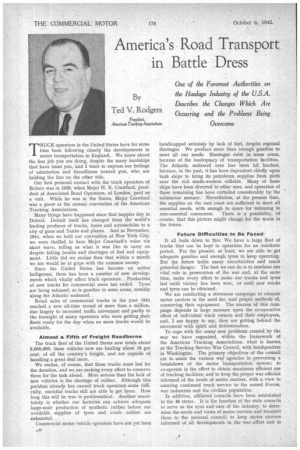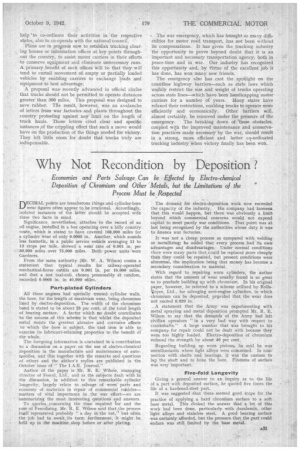America's Road Transport in Battle Dress
Page 32

Page 33

If you've noticed an error in this article please click here to report it so we can fix it.
By Ted V. Rodgers
One of the Foremost Authorities on the Haulage Industry of the U.S.A. Describes the Changes Which Are Occurring and the Problems Being Overcome
TRUCK operators in the United States have for some time been following closely the developments in motor transportation in England. . We know about the fine job you are doing, despite the many hardships that have beset you,Snd I want to express our feelings of admiration and friendliness toward you, who are holding the line on the other side.
Our first personal contact with the truck operators of Britain was in 1938, when Major H. E. Crawfurd, president of Associated Road Operators, of London, paid us a visit. While he was in the States, Major Crawfurd was a guest at the annual convention of the American Trucking Associations.
Many things have happened since that happier day in Detroit. Detroit itself has changed from the world's leading producer of trucks, buses and automobiles to a city of guns and Tanks and planes. And in November, 1941, when we held our convention at New York City, we were thrilled to hear Major Crawfurd's voice via short wave, telling us what it was like to Carry on despite falling bombs and shortages of fuel and equipment. Little did we realize then that within a month we too would be at grips with the common enemy.
Since the United States has become an active belligerent, there has been a number of new developments which vitally affect truck operators. Production. of new trucks for commercial users has ended. Tyres are being rationed; so is gasoline in some areas, notably along the Atlantic seaboard. _
Retail sales of commercial trucks in the year 1941 reached a new all-time record of more than a million, due largely to increased traffic movement and partly to the foresight of many operators who were getting their fleets ready for the day when no more trucks would be available.
Almost a Fifth of Freight Roadborne The truck fleet of the United States now totals about 5,000,000: these vehicles now are hauling about 18 per cent. of all the country's freight, and are capable of handling a great deal more.
We realize, of course, that these trucks must last for the duration, and we are making every effort to conserve them for the task ahead. More serious than the lack of new vehicles is the shortage of rubber. Although this problem already has caused truck operators some difficulty, essential trucks still are able to get tyres. How long this will be true is problematical. Another uncertainty is whether our factories can achieve adequate large-scale production of synthetic rubber before our available, supplies of tyres and crude rubber are exhausted.
Commercial motor vehicle operators have not yet been Axe handicapped seriously by lack of fuel, despite regional shortages. We produce more than enough gasoline to meet all our needs. Shortages exist in some areas, because of the inadequacy of transportation facilities. The Atlantic seaboard area has been hit hardest, because, in the past, it has been dependent chiefly upon tank ships to bring its petroleum supplies from ports near flab rich south-western oilfields. Many of these ships have been diverted to other uses, and operation of those remaining has been curtailed considerably by the submarine menace. Nevertheless, at the present time, the supplies on the east coast are sufficient to tneet all essential needs, with enough to spare for rationing to
non-essential consumers. There is a possibility, of course, that this picture might change for the worse in the future.
Future Difficulties to Be Faced • It all boils clOwn to this: We have alarge fleet of trucks that can be kept in operation for an indefinite period. For the present, at least, we are able to get adequate gasoline and enough tyres to keep operating. But the future holds many uncertainties and much potential danger. The best we can do is to continue our ' vital role in prosecution of the war and, at the same time, make every effort to make our trucks and tyres last Anita victory has been won, or until new trucks and tyres can be obtained.
We are conducting a strenuous campaign to educate motor carriers in the need for, and proper methods of, conserving their equipment. The success of this campaign depends in large measure upon the co-operative effort of individual truck owners and their employees, and, I am happy to say, they are getting behind the movement with spirit and determination.
To cope with the many new problems created by the war we have organized, Within the framework of the American Trucking Associations, what is known. as the Trucking Service War Council, with headquarters in Washington. The primary objectives of the council are to assist the various war agencies in preventing a breakdown of the motor transportation system; to co-operate in the effort to obtain maximum efficient. use of trucking facilities; and to keep the proper war officials informed of the needs of motor carriers, with a view to• assuring continued truck service to the armed Forces, war industries and the civilian population.
In addition, affiliated councils have been established in the 48 states. It is the function of the state councils to serve as the eyes and.ears of the industry; to determine the needs and views of motor carriers and transmit them to the national council; to keep motor carriers informed of all developments in the war .effort and to help *to co-ordinate their activities in the respective stp,tes, also to co-operate with the national council.
Plans are in progress now to establish trucking clearing houses or information offices at key points throughout the country, to assist motor carriers in their efforts to conserve equipment and eliminate unnecessary runs. A primary benefit of such offices will be that they will tend to curtail movement of empty or partially loaded vehicles by enabling carriers to exchange loads and equipment to best advantage.
A proposal was recently advanced in official circles that trucks should not be permitted to operate distances greater than 300 miles. This proposal was designed to save rubber. Tlie result, however, was an avalanche of letters from war factories and plants throughout the country protesting against any limit on the length of truck hauls. These letters cited clear and specific instancespf the crippling effect that such a move would have on the production of the things needed for victory. They left little room for doubt that trucks truly are indispensable. •
The war emergency, which has brought so many difficulties for motor road transport, has not been without its compensations. It has given the trucking industry the opportunity to prove beyond doubt that it is an important and necessary transportation agency, both in peace-time and in war. Our industry has recognized this opportunity and, by itirtue of the excellent job it has done, has won many new friends.
The emergency also has cast the spotlight on the countless highway barriers—such as state laws which unduly restrict the size and weight of trucks operating across state lines—which have been handicapping motor carriers for a number of years. Many states have relaxed their restrictions, enabling trucks to operate more efficiently and economically. Other barriers will, almost certainly, be removed under the pressure of the emergency. The breaking down of 'these obstacles, coupled with the improved maintenance and conservation practices made necessary by the war, should result in a strong, more efficient and better co-ordinated trucking industry when victory finally has been won.




















































